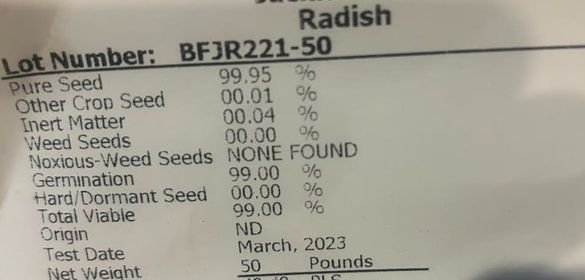Just saw this on a FB page I follow:
A perspective on seed.
I have been in the seed industry for 33 years. When I first entered the distribution world, I had a lot more choices of where to buy. There were continuous releases of new varieties from Ladino clovers to alfalfa to brassica. The seed world was changing due to the Managed Intensive grazing movement. Over the decades the shift began from genetics and quality to price point and ease of purchase. Many of the growers and names of the industry have been replaced. There are many more big hitters with almost a monopoly of sorts in the distribution chain.
There is a much smaller volume of growers in the alfalfa world. One of the largest and most respected companies is no longer in that world. Most of the brassicas come through a large distribution arm with a large volume of the seed originating overseas. You can count the volume of radish and turnip growers on your hands. When I first entered this world, seed was purchased based on quality at a price point where quality was considered. Now, due to the nature of the seed world, people buy for many different reasons.
In the wildlife industry, people tend to buy because of marketing. I rarely get calls or emails asking for tags or the quality of the seed I sell. We are in a world where we either coat poor quality seed or place poor quality seeds in a sealed bag so that people can’t see what they are buying. We also are in a world where legal seed tags are a game in itself. Very few people reading this will even understand a seed tag. Most of you will be afraid to ask for one before purchasing. Seed is just a click away. Where can we buy that seed at the cheapest price?
Is that cheap seed really all that cheap? What if that seed is 80% germ versus 90%? What if that seed contains 35 or 50% seed coatings? Did you know it was low germ and coated before you purchased it? Would you have still bought it? As you squint to look at the tag, you see that it contains 0.50% weeds seeds. That doesn’t sound like a lot, right? What if it was 0.05%? OMG, you just realized you bought 10 times more weed seeds than you should have.
As your staring at the tag, you realize a post that you once read on social media how you could have 1000’s of weed seeds in that bag of seed. Then you look even closer to that bag of Buck on a bag oat and instead of Contains No noxious weeds, it lists Foxtail and fescue. Now what? You look at the tag even closer and you see the test date was from one year ago. Then you realize you once read that southern variety soft seeded forage oats can change from 90% to as low as 16% in less than one year if not stored under ideal conditions. As you shake your head, you mutter to yourself, what did I just do?
My challenge to you all is to not be afraid to ask for tags. Do not be afraid to ask companies what they do with previous years seeds? Do not be afraid to learn where your seed comes from. The higher on the food chain you buy, the likely it will be fresher, more likely to test what is on your tag and with someone who will stand behind what is in the bag.
I attached a couple pics of 2 seeds that came in this week. This is not the norm. There is a whole lot of radish and buckwheat that contains over 1% inert matter. There are a lot of bags of seed out there that contain a lot more weed seeds or other crops. I, myself, smile wide when I am able to purchase this sort of quality. I never need to ask, “NOW WHAT.”


